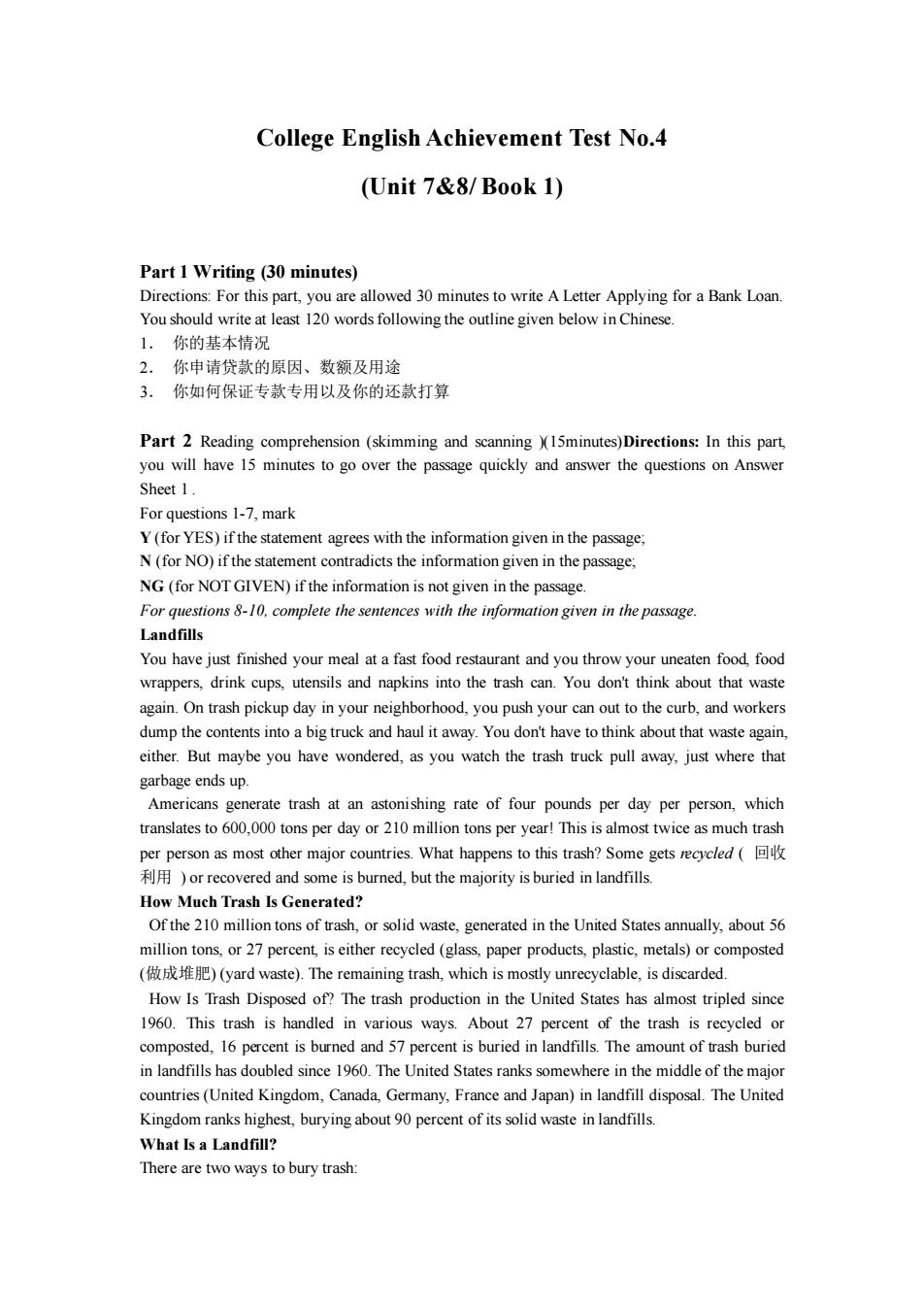
College English Achievement Test No.4 (Unit 7&8/Book 1) Part I Writing (30 minutes) Directions:For this part you are allowed 30 minutes to riteA Letter Applying for a Bank Loan You should write at least 120 words following the outline given below in Chinese. 1.你的基本情况 2.你申请贷款的原因、数额及用途 3.你如何保证专款专用以及你的还款打算 Part 2 Reading comprehension(skimming and scanning (15minutes)Directions:In this part, you will have 15 minutes to go over the passage quickly and answer the questions on Answer Sheet 1. For questions 1-7 mark Y(for YES)ifthe statement agree with the information given in the passage NG(for NOT GIVEN)if the information is not given in the passage. For questions8-10.complete the sentences with the information given in the passage. Landfills yo aneaten food food hink about that wast again.On trash pickup day in your neighborhood,you push your can out to the curb,and workers dump the contents into a big truck and haul it away.You don't have to think about that waste again. either.But maybe you have wondered.as you watch the trash truck pull away.just where that garbage ends up. Ame rate of four pounds per day translates to 600.000 tons per day or 210 million tons per year!This is almost twice as much trash per person as most other major countries.What happens to this trash?Some gets reeyled( )or recovered and some is burned,but the majority is buried in landfills. How Much Trash Is Generated? Ofthe tons of rash,so waste.generated in the United Statesannually,about 56 mi n tons,r27 percent is either recycled (glass,paper products,plastic,metals)orcomposted (做成堆肥)(yard waste)).The remaining trash,.which is mostly unrecyclable,.is discarded How Is Trash Disposed of?The trash production in the United States has almost tripled since 1960.This trash is handled in various ways.About 27 percent of the trash is recvcled or composted 16 per et is buried in landfills The amount ofash buried niddle of the majo countries(United Kingdom,Canada,Germany,France and Japan)in landfill disposal.The United Kingdom ranks highest,burying about 90 percent of its solid waste in landfills. What Is a Landfill? There are two ways to bury trash
College English Achievement Test No.4 (Unit 7&8/ Book 1) Part 1 Writing (30 minutes) Directions: For this part, you are allowed 30 minutes to write A Letter Applying for a Bank Loan. You should write at least 120 words following the outline given below in Chinese. 1. 你的基本情况 2. 你申请贷款的原因、数额及用途 3. 你如何保证专款专用以及你的还款打算 Part 2 Reading comprehension (skimming and scanning )(15minutes)Directions: In this part, you will have 15 minutes to go over the passage quickly and answer the questions on Answer Sheet 1 . For questions 1-7, mark Y (for YES) if the statement agrees with the information given in the passage; N (for NO) if the statement contradicts the information given in the passage; NG (for NOT GIVEN) if the information is not given in the passage. For questions 8-10, complete the sentences with the information given in the passage. Landfills You have just finished your meal at a fast food restaurant and you throw your uneaten food, food wrappers, drink cups, utensils and napkins into the trash can. You don't think about that waste again. On trash pickup day in your neighborhood, you push your can out to the curb, and workers dump the contents into a big truck and haul it away. You don't have to think about that waste again, either. But maybe you have wondered, as you watch the trash truck pull away, just where that garbage ends up. Americans generate trash at an astonishing rate of four pounds per day per person, which translates to 600,000 tons per day or 210 million tons per year! This is almost twice as much trash per person as most other major countries. What happens to this trash? Some gets recycled ( 回收 利用 ) or recovered and some is burned, but the majority is buried in landfills. How Much Trash Is Generated? Of the 210 million tons of trash, or solid waste, generated in the United States annually, about 56 million tons, or 27 percent, is either recycled (glass, paper products, plastic, metals) or composted (做成堆肥) (yard waste). The remaining trash, which is mostly unrecyclable, is discarded. How Is Trash Disposed of? The trash production in the United States has almost tripled since 1960. This trash is handled in various ways. About 27 percent of the trash is recycled or composted, 16 percent is burned and 57 percent is buried in landfills. The amount of trash buried in landfills has doubled since 1960. The United States ranks somewhere in the middle of the major countries (United Kingdom, Canada, Germany, France and Japan) in landfill disposal. The United Kingdom ranks highest, burying about 90 percent of its solid waste in landfills. What Is a Landfill? There are two ways to bury trash:
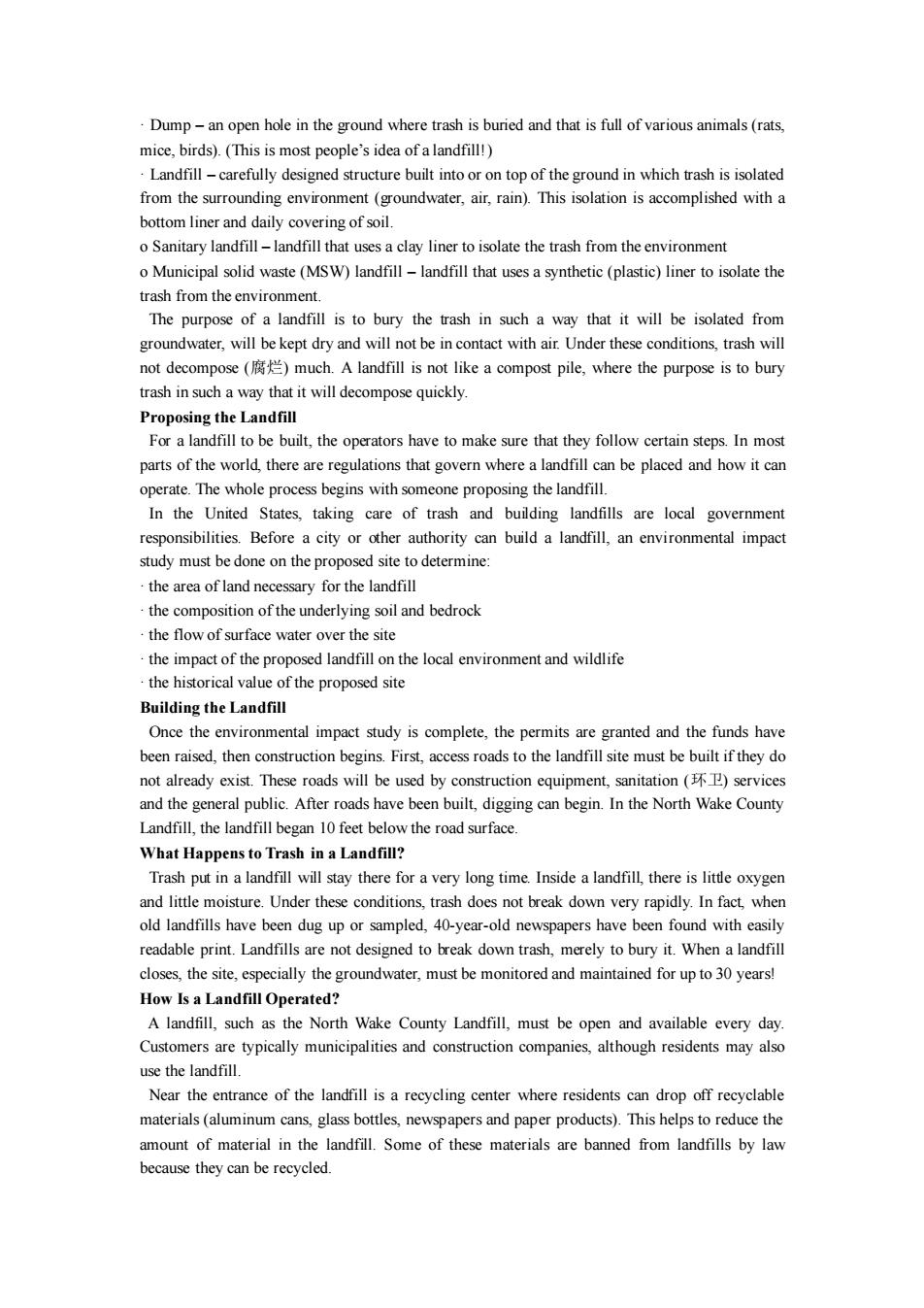
Dump-an open hole in the ground where trash is buried and that is full of various animals (rats. mice,birds).(This is most people'sidea) Landfillcarefully designed structure bult top of the ground nwhichras is from the surrounding environment (groundwater,air,rain).This isolation is accomplished with a bottom liner and daily covering of soil. oSanitary landfill-landfill that uses a clay liner to isolate the trash from the environment o Municipal soid waste(MSW)landfll-andfill that uses a synthetic(plastic)liner toisolate the The purpose of a landfill is to bury the trash in such a way that it will be isolated from groundwater,will be kept dry and will not be in contact with air.Under these conditions,trash will not decompose much.A landfill is not like a compost pile,where the purpose is to bury trash in such a way that it will decompose quickly. t the optr have tomake retat the llow ctin es In mos parts of the world,there are regulations that govern where a landfill can be placed and how it can operate.The whole process begins with someone proposing the landfill. In the United States,taking care of trash and building landfills are local government ntal impact emgw8 ritycn bnevi四 osed site to determine the area of land necessary for the landfill the composition of the underlying soil and bedrock the flow of surface water over the site the impact of the proposed andfill on the of the proposed site Building the Landfl Once the environmental impact study is complete.the permits are granted and the funds have been raised,then construction begins.First,access roads to the landfill site must be built if they do not already exist.These roads will be used by construction equipment,sanitation (services nd the g eneral public.After roads have been built,digging n begin.In the North Wake County ow the road surface What Happens to Trash in a Landfill? Trash put in a landfill will stay there for a very long time Inside a landfill,there is little oxygen and little moisture.Under these conditions,trash does not break down very rapidly.In fact when old landfills have been dug up or sampled,40-year-old newspapers have been found with easily igned to break down tras merely to bu y it.When a landfill closes,the site.especially the groundwater,must be monitored and maintained for up to30 years How Is a Landfill Operated? A landfill,such as the North Wake County Landfill,must be open and available every day Customers are typically municipalities and construction companies,although residents may also use the landfill Near the entrance of the landfill is a recyeling center where residents can drop off reeyelable materials(aluminum cans,glass bottles,newspapers and paper products).This helps to reduce the amount of material in the landfill.Some of these materials are banned from landfills by law because they can be recycled
· Dump – an open hole in the ground where trash is buried and that is full of various animals (rats, mice, birds). (This is most people’s idea of a landfill!) · Landfill – carefully designed structure built into or on top of the ground in which trash is isolated from the surrounding environment (groundwater, air, rain). This isolation is accomplished with a bottom liner and daily covering of soil. o Sanitary landfill – landfill that uses a clay liner to isolate the trash from the environment o Municipal solid waste (MSW) landfill – landfill that uses a synthetic (plastic) liner to isolate the trash from the environment. The purpose of a landfill is to bury the trash in such a way that it will be isolated from groundwater, will be kept dry and will not be in contact with air. Under these conditions, trash will not decompose (腐烂) much. A landfill is not like a compost pile, where the purpose is to bury trash in such a way that it will decompose quickly. Proposing the Landfill For a landfill to be built, the operators have to make sure that they follow certain steps. In most parts of the world, there are regulations that govern where a landfill can be placed and how it can operate. The whole process begins with someone proposing the landfill. In the United States, taking care of trash and building landfills are local government responsibilities. Before a city or other authority can build a landfill, an environmental impact study must be done on the proposed site to determine: · the area of land necessary for the landfill · the composition of the underlying soil and bedrock · the flow of surface water over the site · the impact of the proposed landfill on the local environment and wildlife · the historical value of the proposed site Building the Landfill Once the environmental impact study is complete, the permits are granted and the funds have been raised, then construction begins. First, access roads to the landfill site must be built if they do not already exist. These roads will be used by construction equipment, sanitation (环卫) services and the general public. After roads have been built, digging can begin. In the North Wake County Landfill, the landfill began 10 feet below the road surface. What Happens to Trash in a Landfill? Trash put in a landfill will stay there for a very long time. Inside a landfill, there is little oxygen and little moisture. Under these conditions, trash does not break down very rapidly. In fact, when old landfills have been dug up or sampled, 40-year-old newspapers have been found with easily readable print. Landfills are not designed to break down trash, merely to bury it. When a landfill closes, the site, especially the groundwater, must be monitored and maintained for up to 30 years! How Is a Landfill Operated? A landfill, such as the North Wake County Landfill, must be open and available every day. Customers are typically municipalities and construction companies, although residents may also use the landfill. Near the entrance of the landfill is a recycling center where residents can drop off recyclable materials (aluminum cans, glass bottles, newspapers and paper products). This helps to reduce the amount of material in the landfill. Some of these materials are banned from landfills by law because they can be recycled
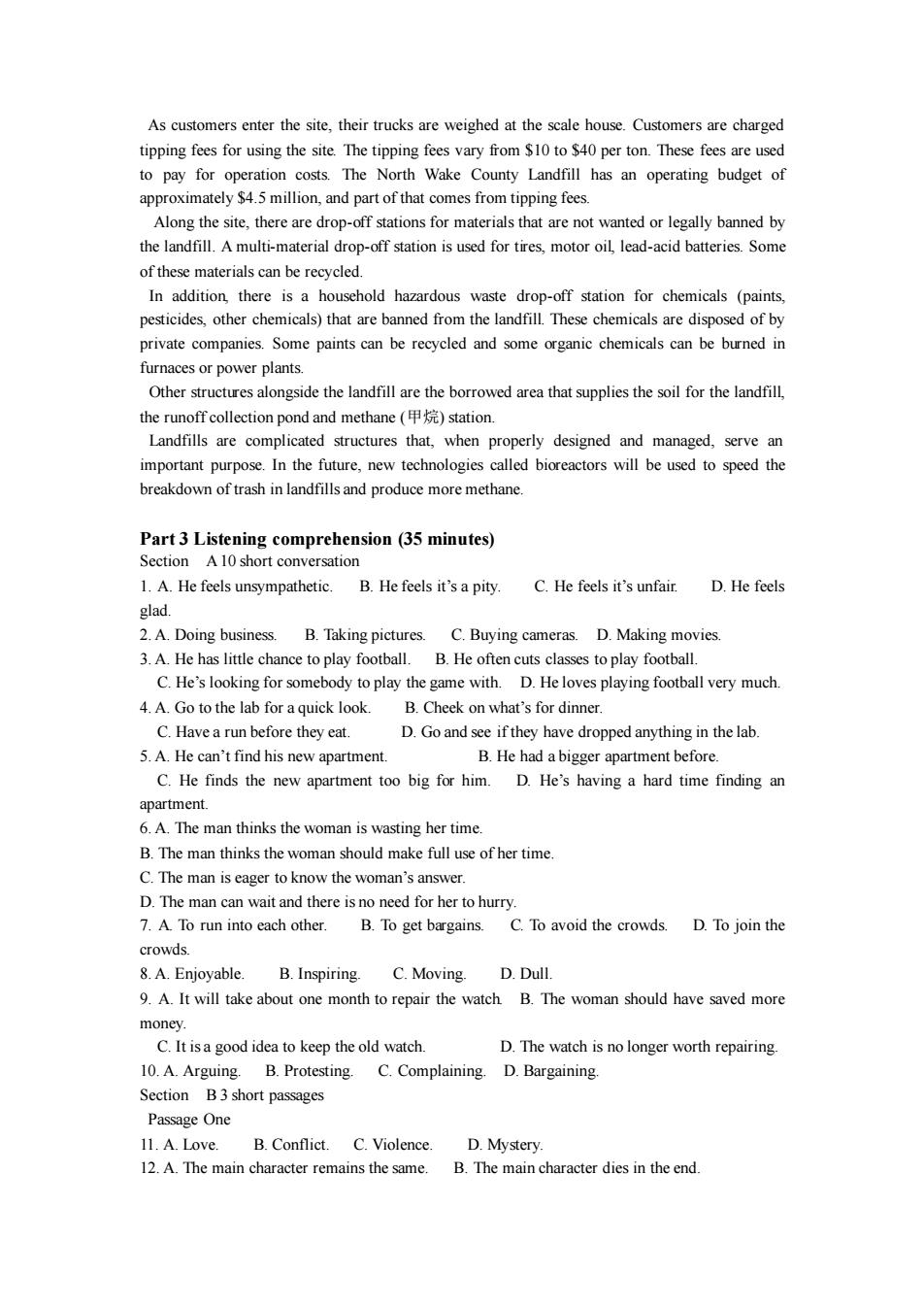
As customers enter the site.their trucks are weighed at the scale bouse.Customers are charged to pay for operation costs.The North Wake County Landfill has an operating budget of approximately $4.5 million,and part of that comes from tipping fees. Along the site,there are drop-off stations for materials that are not wanted or legally banned by the landfill.A multi-material drop-off station is used for tires.motor oil.lead-acid batteries.Some of these materials can be recycled In addition there is a household hazardous waste drop-off station for chemicals (paint pesticides,other chemicals)that are banned from the landfill.These chemicals are disposed of by private companies.Some paints can be recycled and some organic chemicals can be burned in furnaces or nower plants Other structures alongside the landfill are the borrowed area that supplies the soil for the landfill, the pond and methane ()station Landfills are complicated structures that,when properly designed and managed,serve an important purpose.In the future,new technologies called bioreactors will be used to speed the breakdown of trash in landfills and produce more methane. Part 3 Listening comprehension (35 minutes) ion A 10 short conversation 1.A.He feels unsympathetic. B.He feels it's a pity. C.He feels it's unfair D.He feels glad 2.A.Doing business. B Taking pictures c Buving cameras d making movies 3.A.He has little chance to play football. B.He often cuts classes toplay football. C.He'slooking for somebody 4.A.Go to the lab for a quick look B.Cheek on what's for dinner. C.Have a run before they eat. D.Go and see if they have dropped anything in the lab. 5.A.He can't find his new apartment. B.He had a bigger apartment before. C.He finds the new apartment too big for him.D.He's shaving a hard time finding an B.The man thinks the woman should make full use of her time C.The man is eager to know the woman's answer. D.The man can wait and there is no need for her to hurry 7 A To run into each other B.To get bargains C.To avoid the erowds.D.To join the crowds 8.A.Enjoyable. B.Inspiring. C.Moving.D.Dull. 9.A.It will take about one month to repair the watch B.The woman should have saved more monev C.Itisa good idea to keep the od watch. D.The watch is no longer worth repairing 10.A.Argu B.Protesting C.Complaining.D.Bargaining Section B3 short passages Passage One 11.A.Love.B.Conflict.C.Violence. D.Mystery 12.A.The main character remains the same B.The main character dies in the end
As customers enter the site, their trucks are weighed at the scale house. Customers are charged tipping fees for using the site. The tipping fees vary from $10 to $40 per ton. These fees are used to pay for operation costs. The North Wake County Landfill has an operating budget of approximately $4.5 million, and part of that comes from tipping fees. Along the site, there are drop-off stations for materials that are not wanted or legally banned by the landfill. A multi-material drop-off station is used for tires, motor oil, lead-acid batteries. Some of these materials can be recycled. In addition, there is a household hazardous waste drop-off station for chemicals (paints, pesticides, other chemicals) that are banned from the landfill. These chemicals are disposed of by private companies. Some paints can be recycled and some organic chemicals can be burned in furnaces or power plants. Other structures alongside the landfill are the borrowed area that supplies the soil for the landfill, the runoff collection pond and methane (甲烷) station. Landfills are complicated structures that, when properly designed and managed, serve an important purpose. In the future, new technologies called bioreactors will be used to speed the breakdown of trash in landfills and produce more methane. Part 3 Listening comprehension (35 minutes) Section A 10 short conversation 1. A. He feels unsympathetic. B. He feels it’s a pity. C. He feels it’s unfair. D. He feels glad. 2. A. Doing business. B. Taking pictures. C. Buying cameras. D. Making movies. 3. A. He has little chance to play football. B. He often cuts classes to play football. C. He’s looking for somebody to play the game with. D. He loves playing football very much. 4. A. Go to the lab for a quick look. B. Cheek on what’s for dinner. C. Have a run before they eat. D. Go and see if they have dropped anything in the lab. 5. A. He can’t find his new apartment. B. He had a bigger apartment before. C. He finds the new apartment too big for him. D. He’s having a hard time finding an apartment. 6. A. The man thinks the woman is wasting her time. B. The man thinks the woman should make full use of her time. C. The man is eager to know the woman’s answer. D. The man can wait and there is no need for her to hurry. 7. A. To run into each other. B. To get bargains. C. To avoid the crowds. D. To join the crowds. 8. A. Enjoyable. B. Inspiring. C. Moving. D. Dull. 9. A. It will take about one month to repair the watch. B. The woman should have saved more money. C. It is a good idea to keep the old watch. D. The watch is no longer worth repairing. 10. A. Arguing. B. Protesting. C. Complaining. D. Bargaining. Section B 3 short passages Passage One 11. A. Love. B. Conflict. C. Violence. D. Mystery. 12. A. The main character remains the same. B. The main character dies in the end
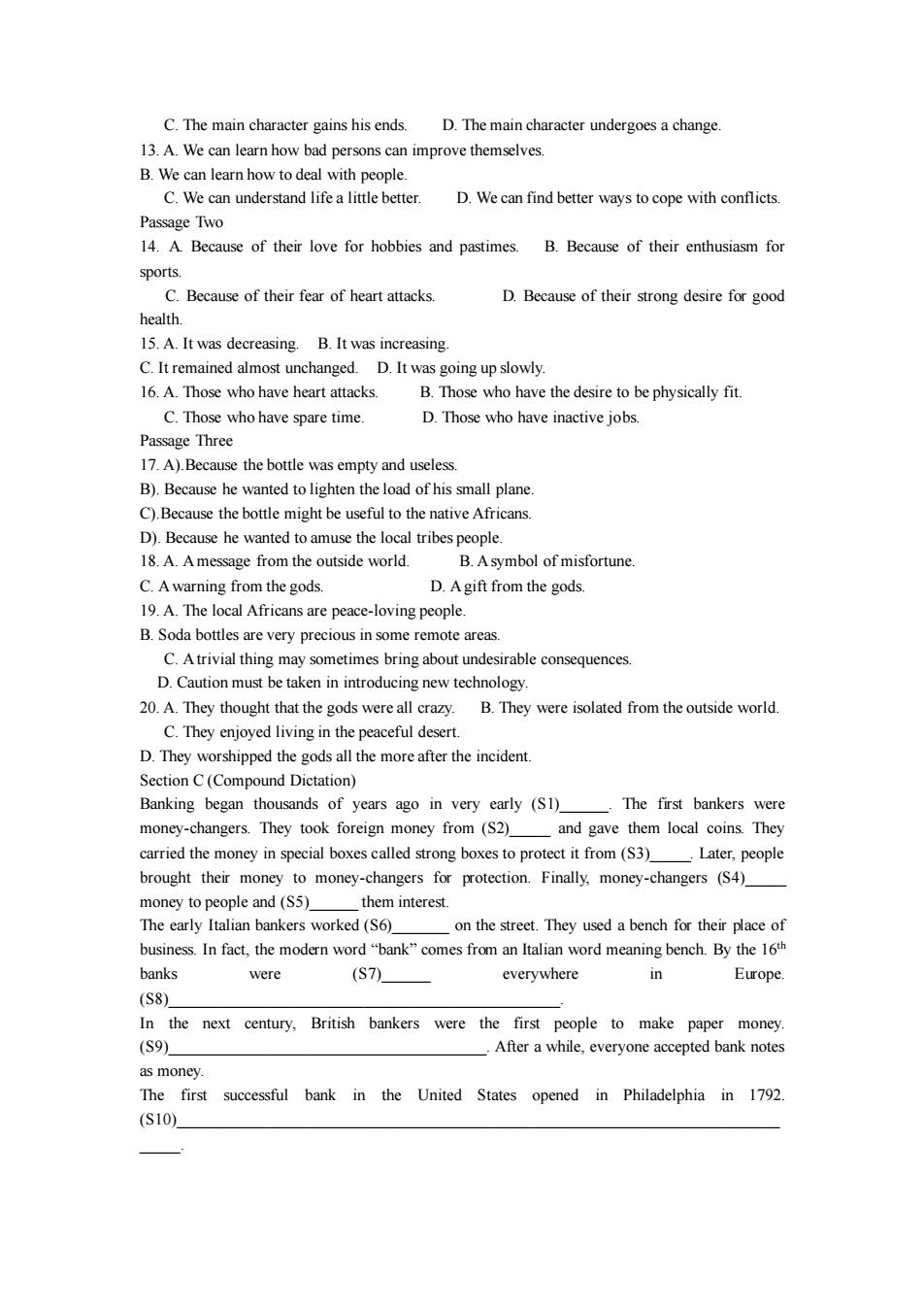
C.The main character gains his ends. D.The main character undergoes a change 13.A.We can learn how bad persons can improve themselves C.We can understand life a little bette D.We can find better ways to cope with conflicts Passage Two 14.A.Because of their love for hobbies and pastimes.B.Because of their enthusiasm for sports. C.Because of their fear of heart attacks D.Because of their strong desire for good 15.A.It was decreasing.B.It was increasing. C.It remained almost unchanged.D.It was going up slowly. 16.A.Those who have heart attacks B.Those who have the desire to be physically fit. C.Those who have spare time D.Those who have inactive jobs sage Three 17.A).Because the bottle was empty and useless. B).Because he wanted to lighten the load of his small plane. C).Because the bottle might be useful to the native Africans D).Because he wanted to 18.A.Amessae from the outside wor A symbol of misfortune C.A warning from the gods. D.Agift from the gods. 19.A.The local Africans are peace-loving people. B.Soda bottles are very precious in some remote areas. C.Atrivial thing m may sometimes bring about undesirable consquences D Ca atiol g new tec nology 20.A.They thought that the gods wereall crazy. B.They were isolated from the outside world C.They enjoyed living in the peaceful desert. D.They worshipped the gods all the more after the incident. Section C(Compound Dictation) Banking began thousands of years ago in very early (S1) The first bankers were money-changers.They took foreign money from (S2) and gave them local coins They carried the money in special boxes called strong boxes to protect it from (S3) Later,people brought their money to money-changers for protection.Finally,money-changers (S4) money to people and (S5) them interest. The early Italian bankers worked (S6) on the street They used a bench for their place of business In fact,the modrn wo "bank"comes from an Itaian word meaning bench.By the16h banks were (S7) everywhere Europe (S8) In the next century,British bankers were the first people to make paper money (S9) After a while,everyone accepted bank notes bank in the United States opened in Philadelphia in 1792 (S10)
C. The main character gains his ends. D. The main character undergoes a change. 13. A. We can learn how bad persons can improve themselves. B. We can learn how to deal with people. C. We can understand life a little better. D. We can find better ways to cope with conflicts. Passage Two 14. A. Because of their love for hobbies and pastimes. B. Because of their enthusiasm for sports. C. Because of their fear of heart attacks. D. Because of their strong desire for good health. 15. A. It was decreasing. B. It was increasing. C. It remained almost unchanged. D. It was going up slowly. 16. A. Those who have heart attacks. B. Those who have the desire to be physically fit. C. Those who have spare time. D. Those who have inactive jobs. Passage Three 17. A).Because the bottle was empty and useless. B). Because he wanted to lighten the load of his small plane. C).Because the bottle might be useful to the native Africans. D). Because he wanted to amuse the local tribes people. 18. A. A message from the outside world. B. A symbol of misfortune. C. A warning from the gods. D. A gift from the gods. 19. A. The local Africans are peace-loving people. B. Soda bottles are very precious in some remote areas. C. A trivial thing may sometimes bring about undesirable consequences. D. Caution must be taken in introducing new technology. 20. A. They thought that the gods were all crazy. B. They were isolated from the outside world. C. They enjoyed living in the peaceful desert. D. They worshipped the gods all the more after the incident. Section C (Compound Dictation) Banking began thousands of years ago in very early (S1)______. The first bankers were money-changers. They took foreign money from (S2)_____ and gave them local coins. They carried the money in special boxes called strong boxes to protect it from (S3)_____. Later, people brought their money to money-changers for protection. Finally, money-changers (S4)_____ money to people and (S5)______ them interest. The early Italian bankers worked (S6)_______ on the street. They used a bench for their place of business. In fact, the modern word “bank” comes from an Italian word meaning bench. By the 16th banks were (S7)______ everywhere in Europe. (S8)________________________________________________. In the next century, British bankers were the first people to make paper money. (S9)_______________________________________. After a while, everyone accepted bank notes as money. The first successful bank in the United States opened in Philadelphia in 1792. (S10)__________________________________________________________________________ _____
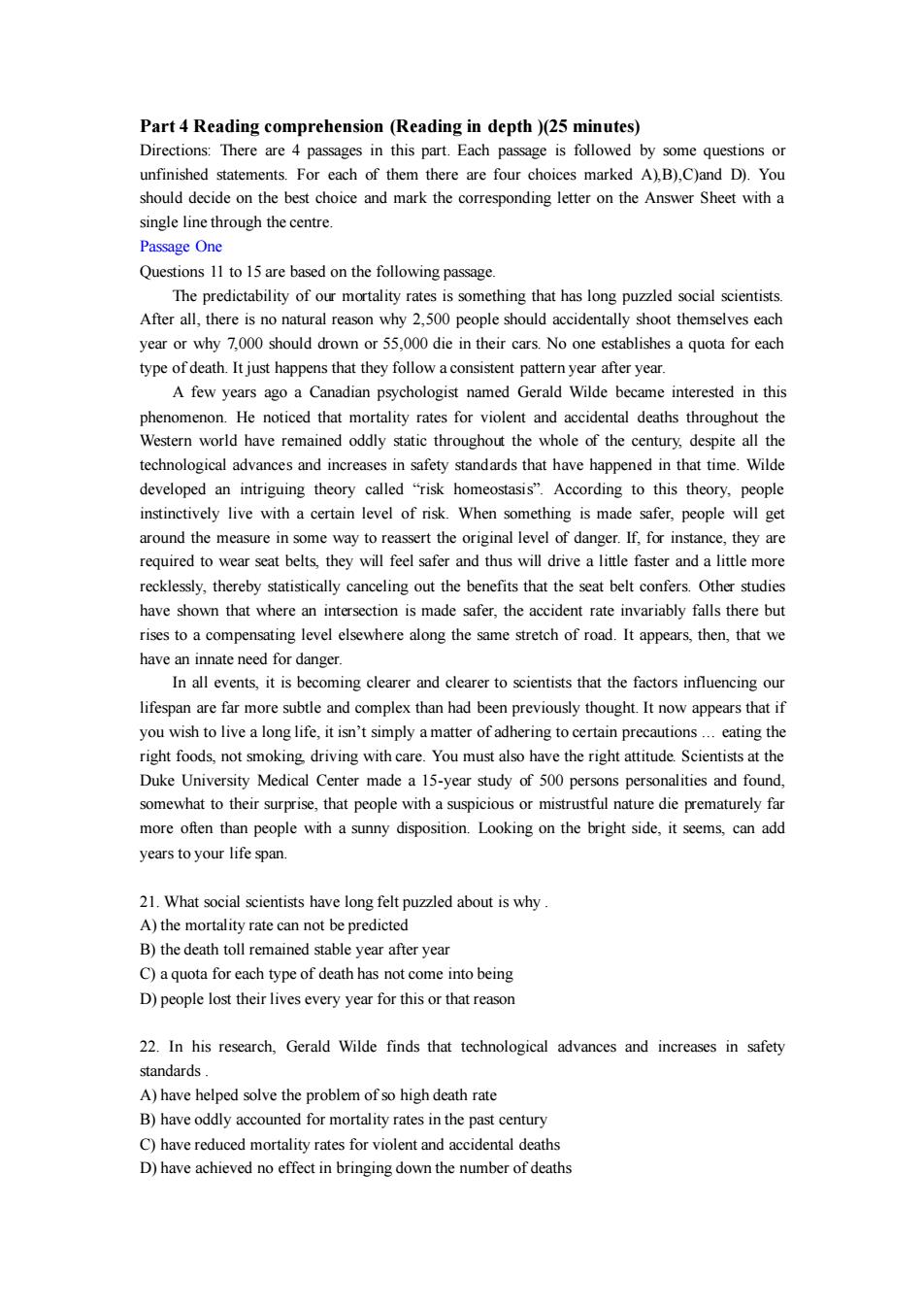
Part4 Reading(Reading in depth 25 minutes) by some questions or unfinished statements.For each of them there are four choices marked A)B),C)and D).You should decide on the best choice and mark the corresponding letter on the Answer Sheet with a single line through the centre. Passage One Questions to15are based on the following passae The predictability of morality rates issmething that has social scientis After all,there is no natural reason why 2.500 people should accidentally shoot themselves each year or why 7.000 should drown or 55,000 die in their cars.No one establishes a quota for each type of death.It just happens that they follow aconsistent pattern year after year. A few years ago a Canadian psychologist named Gerald Wilde became interested in this h enomenon.He noticed that mo tality rates for violent and accidental deaths throughout the Western world have remained oddly static throughout the whole of the century,despite all the technological advances and increases in safety standards that have happened in that time.Wilde developed an intriguing theory called"risk homeostasis".According to this theory,people Fae5g34川e3 up IILM S中pue Jates1ea1MA3印Sq1se3m01”。 e me ay t the original If,for n recklessly,thereby statistically canceling out the benefits that the seat belt confers.Other studies have shown that where an intersection is made safer,the accident rate invariably falls there but rises to a compensating level elsewhere along the same stretch of road.It appears,then,that we have an inate ed for danger Inall events,it is bcoming erer to that the factors lifespan are far more subtle and complex than had been previously thought.It now appears that if you wish to live a long life,it isn't simply a matter of adhering to certain precautions...eating the right foods.not smoking driving with care.You must also have the right attitude Scientists at the Du University Medical Center made -year uy pers onalities and found attotheir sur that peop le with a suspic mist more ofn than people with a sunny disposition.Lookingon the bright side.it seems.cn add years to your life span. 21.What social scientists have long felt puzzled about is why A)the mortality rte cannot be predicted C)a quota for each type of death has not come into being D)people lost their lives every year for this or that reason 22.In his research,Gerald Wilde finds that technological advances and increases in safety standards A)have helped solve the problem of so high death rate B)have oddly accounted for mortality rates in the past century C)have reduced mortality rates for violent and accidental deaths D)have achieved no effect in bringing down the number of deaths
Part 4 Reading comprehension (Reading in depth )(25 minutes) Directions: There are 4 passages in this part. Each passage is followed by some questions or unfinished statements. For each of them there are four choices marked A),B),C)and D). You should decide on the best choice and mark the corresponding letter on the Answer Sheet with a single line through the centre. Passage One Questions 11 to 15 are based on the following passage. The predictability of our mortality rates is something that has long puzzled social scientists. After all, there is no natural reason why 2,500 people should accidentally shoot themselves each year or why 7,000 should drown or 55,000 die in their cars. No one establishes a quota for each type of death. It just happens that they follow a consistent pattern year after year. A few years ago a Canadian psychologist named Gerald Wilde became interested in this phenomenon. He noticed that mortality rates for violent and accidental deaths throughout the Western world have remained oddly static throughout the whole of the century, despite all the technological advances and increases in safety standards that have happened in that time. Wilde developed an intriguing theory called “risk homeostasis”. According to this theory, people instinctively live with a certain level of risk. When something is made safer, people will get around the measure in some way to reassert the original level of danger. If, for instance, they are required to wear seat belts, they will feel safer and thus will drive a little faster and a little more recklessly, thereby statistically canceling out the benefits that the seat belt confers. Other studies have shown that where an intersection is made safer, the accident rate invariably falls there but rises to a compensating level elsewhere along the same stretch of road. It appears, then, that we have an innate need for danger. In all events, it is becoming clearer and clearer to scientists that the factors influencing our lifespan are far more subtle and complex than had been previously thought. It now appears that if you wish to live a long life, it isn’t simply a matter of adhering to certain precautions … eating the right foods, not smoking, driving with care. You must also have the right attitude. Scientists at the Duke University Medical Center made a 15-year study of 500 persons personalities and found, somewhat to their surprise, that people with a suspicious or mistrustful nature die prematurely far more often than people with a sunny disposition. Looking on the bright side, it seems, can add years to your life span. 21. What social scientists have long felt puzzled about is why . A) the mortality rate can not be predicted B) the death toll remained stable year after year C) a quota for each type of death has not come into being D) people lost their lives every year for this or that reason 22. In his research, Gerald Wilde finds that technological advances and increases in safety standards . A) have helped solve the problem of so high death rate B) have oddly accounted for mortality rates in the past century C) have reduced mortality rates for violent and accidental deaths D) have achieved no effect in bringing down the number of deaths